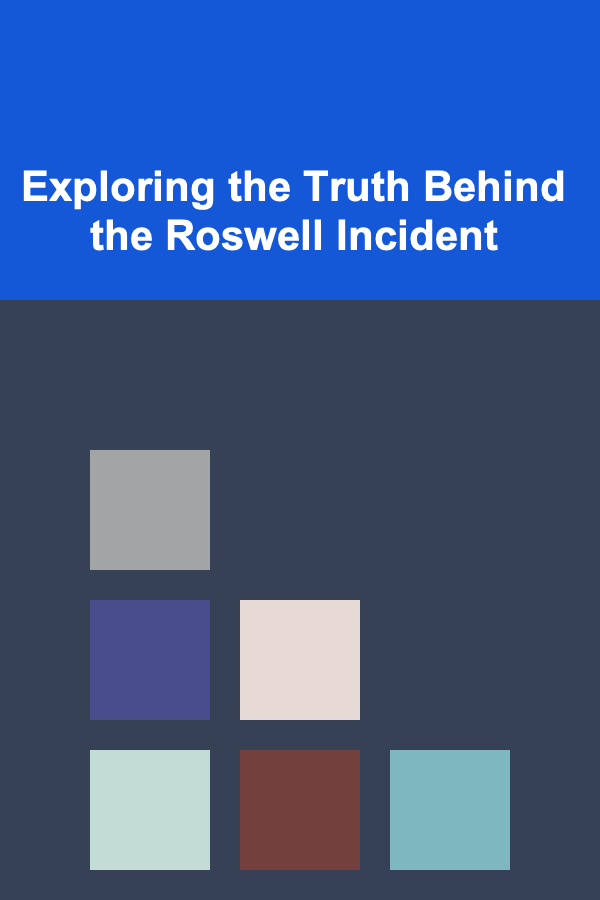
Exploring the Truth Behind the Roswell Incident
ebook include PDF & Audio bundle (Micro Guide)
$12.99$5.99
Limited Time Offer! Order within the next:

Introduction: The Enduring Mystery of Roswell
The Roswell Incident, a purported UFO crash near Roswell, New Mexico, in July 1947, remains one of the most debated and analyzed events in UFO lore. Decades after it occurred, it continues to fuel speculation, conspiracy theories, and intense interest from both the public and researchers alike. The official explanation -- that the debris was from a Project Mogul balloon, a top-secret program designed to detect Soviet atomic bomb tests -- has never fully satisfied many, leading to a cottage industry of books, documentaries, and investigations dedicated to uncovering the "truth." This exploration aims to provide a framework for critically examining the evidence, identifying biases, and understanding the complexities surrounding the Roswell Incident, ultimately empowering readers to form their own informed conclusions. It is not intended to provide a definitive answer -- that remains elusive -- but rather to equip you with the tools necessary to navigate the labyrinth of information and misinformation.
Understanding the Historical Context
To effectively analyze the Roswell Incident, understanding the socio-political climate of 1947 is crucial. The United States was emerging from World War II, a global conflict that had showcased unprecedented technological advancements and instilled a pervasive sense of both national pride and Cold War paranoia. The atomic bombings of Hiroshima and Nagasaki had fundamentally altered the global power dynamic and ushered in an era of existential dread. This environment of heightened secrecy, coupled with a rapidly developing aerospace industry, provided fertile ground for rumors and speculation about advanced technologies, both terrestrial and potentially extraterrestrial.
The immediate postwar period also witnessed a surge in UFO sightings, often attributed to "flying saucers" after Kenneth Arnold's famous report of seeing nine objects flying near Mount Rainier in June 1947, just weeks before the Roswell Incident. This widespread public interest, coupled with the nascent Cold War security concerns, likely influenced how the military handled the situation and contributed to the subsequent confusion and controversy.
Key Players and Their Accounts
The Roswell Incident involves a complex web of individuals whose accounts, often conflicting, form the foundation of the narrative. Understanding their backgrounds and motivations is essential for evaluating the credibility of their testimonies.
- W.W. Brazel: The rancher who discovered the debris field. His initial descriptions of the material as being unlike anything he had ever seen fueled the initial speculation. Later, he seemed to retract or modify his statements, possibly under pressure from the military. His reliability as a primary source is often debated due to these inconsistencies and potential external influences.
- Major Jesse Marcel: The intelligence officer from Roswell Army Air Field (RAAF) who was initially sent to investigate the debris. He publicly stated that the material he saw was not from any known aircraft or weather balloon. His later statements, some made much later in life, have become central to the UFO narrative. Marcel's involvement and subsequent statements are heavily scrutinized by both proponents and skeptics.
- Colonel William Blanchard: The commander of the 509th Bomb Group at RAAF. He initially issued a press release stating that the military had recovered a "flying disc." This press release is often cited as evidence of a cover-up when it was quickly retracted.
- Brigadier General Roger Ramey: The commanding general of the Eighth Air Force in Fort Worth, Texas. He presented the recovered debris to the press, claiming it was from a weather balloon. The "Ramey Memo," visible in photographs taken during the press conference, has been intensely analyzed for clues about the true nature of the recovered object.
- Various Witnesses: Numerous other individuals, including military personnel, civilians, and even alleged morticians, have come forward over the years with their accounts of the Roswell Incident. These accounts vary widely in detail and credibility, further complicating the picture. Their motivations range from genuine recollection to seeking attention, and their stories often lack corroborating evidence.
Analyzing these accounts requires a critical eye, considering factors such as the passage of time, potential memory distortions, the influence of suggestion, and the possibility of deliberate fabrication. It's crucial to cross-reference these accounts with available documentation and physical evidence, while acknowledging the inherent limitations of eyewitness testimony.
The Official Explanations: Project Mogul and Beyond
The U.S. Air Force has issued several reports attempting to debunk the UFO claims surrounding the Roswell Incident. The most prominent explanation is that the debris recovered was from a Project Mogul balloon, a top-secret program designed to detect Soviet atomic bomb tests by monitoring sound waves in the upper atmosphere. These balloons carried radar reflectors and microphones and were launched from nearby Alamogordo Army Air Field.
The Air Force reports also addressed claims of alien bodies being recovered, attributing these stories to misidentified injuries sustained in other unrelated accidents, including the 1950s series of high-altitude balloon experiments using dummies. They argued that the memories of these events, coupled with the pervasive cultural fascination with UFOs, led to the conflation and embellishment of the Roswell narrative over time.
However, these official explanations have been met with skepticism. Critics point to inconsistencies in the Air Force's timeline, the perceived inadequacy of the Mogul explanation to account for all the reported features of the debris, and the alleged withholding of information. The very fact that the Air Force has issued multiple reports over the years is sometimes seen as an admission that the initial explanation was insufficient.
Analyzing the Physical Evidence: Debris and Its Composition
The nature of the debris recovered from the Roswell crash site is a central point of contention. Descriptions of the material vary widely, ranging from lightweight, incredibly strong substances to materials exhibiting unusual properties such as the ability to return to their original shape after being crumpled. Proponents of the UFO theory argue that these properties are inconsistent with known terrestrial materials, suggesting an extraterrestrial origin.
Skeptics, on the other hand, maintain that the debris can be accounted for by materials used in Project Mogul balloons, such as neoprene, balsa wood, and special tapes. They also point to the limited physical evidence available for independent analysis, as much of the original debris was reportedly collected by the military. The absence of verifiable physical artifacts makes it difficult to definitively determine the origin and composition of the material.
Furthermore, the descriptions of the debris have evolved over time, often becoming more elaborate and sensationalized. This raises questions about the reliability of these accounts and the potential for exaggeration or misremembering.
The Alien Body Claims: A Contentious Aspect
Perhaps the most controversial aspect of the Roswell Incident is the alleged recovery of alien bodies. While the initial reports focused primarily on the debris, stories of extraterrestrial beings emerged later, particularly in the 1970s and 1980s. These accounts typically describe small, gray-skinned humanoids with large heads and eyes.
The Air Force reports addressed these claims by attributing them to misidentified injuries sustained by airmen in unrelated accidents, including parachute training exercises and high-altitude balloon experiments using dummies. They presented evidence suggesting that the descriptions of the "alien bodies" closely matched the physical characteristics of these dummies. The "Project High Dive" experiments, in particular, have been cited as a possible source of confusion.
However, proponents of the alien body claims dispute these explanations, arguing that the descriptions of the beings are too consistent and detailed to be attributed solely to misidentification. They also allege that the government has suppressed evidence of the alien bodies, including autopsy reports and photographs. The lack of definitive physical evidence, combined with the highly sensationalized nature of these claims, makes it difficult to assess their veracity.
The Role of Conspiracy Theories and Cover-Ups
The Roswell Incident has become a cornerstone of UFO conspiracy theories, with many believing that the U.S. government has deliberately concealed the truth about the event. These theories often posit that the government is hiding evidence of recovered alien technology and attempting to prevent public panic.
Arguments supporting these conspiracy theories often cite inconsistencies in official statements, the alleged intimidation of witnesses, and the perceived lack of transparency surrounding the incident. They also point to the fact that many documents related to Roswell remain classified, fueling suspicion about what the government is hiding.
However, skeptics argue that the alleged cover-up is an oversimplification of a complex situation. They suggest that the government's actions can be explained by a combination of legitimate national security concerns, Cold War secrecy, and a desire to avoid public hysteria. They also argue that the lack of conclusive evidence supporting the alien body claims weakens the case for a deliberate cover-up.
It's important to approach conspiracy theories with a critical mindset, considering the motivations of those promoting them and the evidence they present. While it's possible that the government has withheld information about Roswell, it's also important to acknowledge the potential for misinformation, exaggeration, and outright fabrication.
Methodologies for Critical Investigation
Exploring the truth behind the Roswell Incident requires a rigorous and critical approach. Here are some key methodologies to employ:
- Source Criticism: Evaluate the credibility of all sources, considering their biases, motivations, and expertise. Cross-reference information from multiple sources to identify inconsistencies and verify claims.
- Evidence-Based Reasoning: Base conclusions on verifiable evidence, not speculation or hearsay. Distinguish between facts, opinions, and interpretations.
- Logical Fallacies: Be aware of common logical fallacies, such as appeals to authority, ad hominem attacks, and straw man arguments.
- Cognitive Biases: Recognize and mitigate the influence of cognitive biases, such as confirmation bias (seeking out information that confirms pre-existing beliefs) and the bandwagon effect (adopting beliefs simply because they are popular).
- Historical Context: Understand the historical, social, and political context in which the Roswell Incident occurred. This will help to interpret events and understand the motivations of the individuals involved.
- Scientific Literacy: Develop a basic understanding of scientific principles and methodologies. This will help to evaluate claims about advanced technology and alien biology.
- Skepticism: Approach all claims with a healthy dose of skepticism, demanding evidence and critical scrutiny.
Specific Questions to Ask When Evaluating Roswell Claims
When encountering claims about the Roswell Incident, consider asking the following questions:
- Who is making the claim, and what is their background? (Are they a credible expert, a firsthand witness, or someone with a vested interest?)
- What evidence is presented to support the claim? (Is it verifiable, circumstantial, or based on hearsay?)
- Are there any inconsistencies in the claim or the evidence presented?
- Does the claim contradict established scientific principles or historical facts?
- What is the motivation behind making the claim? (Is it to inform, to persuade, or to profit?)
- Has the claim been independently verified by other sources?
- Are there alternative explanations for the events being described?
- How does the claim fit into the broader context of the Roswell Incident?
The Enduring Appeal of the Roswell Incident
Despite the lack of definitive proof, the Roswell Incident continues to captivate the public imagination. Its enduring appeal can be attributed to several factors:
- The Mystery Element: The unresolved nature of the incident leaves room for speculation and imagination, fueling the desire to uncover the "truth."
- The Human Desire for Connection: The possibility of extraterrestrial life resonates with a deep-seated human desire to understand our place in the universe and to connect with other intelligent beings.
- The Underdog Narrative: The idea that the government is concealing information from the public appeals to a sense of distrust in authority and a desire to fight for transparency.
- The Power of Storytelling: The Roswell Incident has been woven into countless stories, documentaries, and films, further solidifying its place in popular culture.
- The Technological Fascination: Claims of advanced alien technology pique our interest in innovation and the potential for breakthroughs that could transform our world.
Conclusion: Seeking Truth in a Sea of Uncertainty
The Roswell Incident remains a complex and controversial event, shrouded in mystery and misinformation. While definitive proof of an extraterrestrial encounter remains elusive, the incident serves as a valuable case study in critical thinking, source evaluation, and the power of human belief. By employing a rigorous and skeptical approach, examining the available evidence, and understanding the historical and social context, individuals can navigate the labyrinth of information and form their own informed conclusions. The quest for truth is often a journey rather than a destination, and the Roswell Incident offers a compelling example of the challenges and rewards of that pursuit.
Ultimately, whether one believes that the Roswell Incident involved a crashed UFO or a mundane weather balloon, the event has left an indelible mark on popular culture and continues to inspire debate and fascination. The most important lesson to take away is the importance of critical thinking and the constant need to question and analyze information, especially when it comes to extraordinary claims.
Disclaimer: This article presents a balanced perspective on the Roswell Incident and does not endorse any specific theory. The information presented is based on publicly available sources and should be interpreted with caution. The author is not responsible for any decisions made based on the information presented in this article.

How to Build a Family Indoor Fort for a Cozy Movie Marathon
Read More
How to Use Customer Reviews and Testimonials as Content for Your Dropshipping Website
Read More
How to Use LinkedIn InMail to Connect with Potential Dropshipping Partners
Read More
Sustainable Shopping: Tips for Buying in Bulk and Reducing Waste
Read More
Securing Your Bluetooth Connections: A Comprehensive Guide
Read More
How to Deal with Debt Collectors Without Damaging Your Credit
Read MoreOther Products

How to Build a Family Indoor Fort for a Cozy Movie Marathon
Read More
How to Use Customer Reviews and Testimonials as Content for Your Dropshipping Website
Read More
How to Use LinkedIn InMail to Connect with Potential Dropshipping Partners
Read More
Sustainable Shopping: Tips for Buying in Bulk and Reducing Waste
Read More
Securing Your Bluetooth Connections: A Comprehensive Guide
Read More